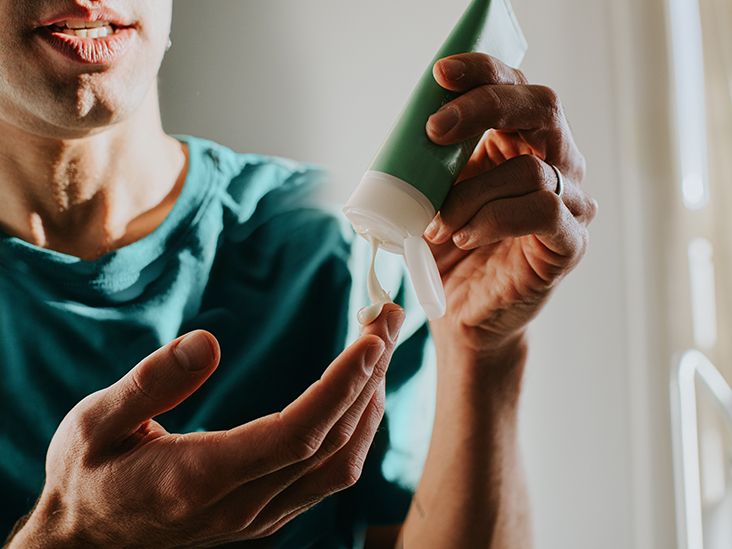Facial psoriasis occurs due to your genetics and immune system and can cause painful or itchy plaques on your face. Treatment may include medications and lifestyle practices.
The majority of people with facial psoriasis also have scalp psoriasis. Some also have moderate to severe psoriasis affecting other parts of their body.
Psoriasis is a common chronic inflammatory skin condition that causes inflammation in the body. It can cause extra cells to build up on your skin. This results in scaly plaques that can be painful and itchy. They may appear differently depending on your skin tone:
- On fair to lighter skin tones, the plaques tend to be pink or red with silvery-white scales.
- On medium skin tones, the plaques can appear salmon-colored with silvery-white scales.
- On darker skin tones, the plaques can look violet with gray scales, or they can also be dark brown and difficult to see.
These plaques can come and go, flaring up for weeks or months before becoming less noticeable.
There are several forms of facial psoriasis that may cause different symptoms. With each, your skin may be:
- itchy
- painful
- irritated
Psoriasis around the eyes can lead to inflamed, crusty eyelids, and eyelashes potentially rubbing against the eye. Psoriasis inside and around the ear can potentially affect your hearing.
Plaque psoriasis, the most common form, tends to appear as raised, scaly plaques, while guttate psoriasis can look like drops with smaller and less thick spots.
Erythrodermic psoriasis is rare and tends to come with a widespread rash and may look red, dark brown, or purple, depending on your skin tone. It may also lead to shifts in body temperature and an increased chance of infection.
Other types of psoriasis, such as scalp psoriasis, may appear alongside facial psoriasis.
A
Scratching plaques may lead to broken skin and infection. Psoriasis can also affect your self-image and general quality of life.
The three main subtypes of psoriasis that appear on the face are the following:
Hairline psoriasis

Hairline psoriasis is scalp psoriasis (plaque psoriasis) that has spread beyond your hairline onto your forehead and in and around your ears. Psoriasis scales in your ears can build up and block your ear canal.
Sebopsoriasis

Sebopsoriasis results in symptoms of both psoriasis and seborrheic dermatitis. Seborrheic dermatitis is a common, chronic form of eczema that usually affects the scalp and causes dandruff. It may affect other parts of the body as well.
Sebopsoriasis is often patchy at your hairline. It can appear on:
- eyebrows
- eyelids
- beard area
- the area where your nose meets your cheeks
Even though sebopsoriasis is commonly associated with scalp psoriasis, the plaques are often thinner with a lighter color and smaller scales.
Facial psoriasis

Facial psoriasis can appear on any part of your face and is associated with psoriasis on other parts of your body, including your:
- scalp
- ears
- elbow
- knees
- torso
It can be plaque psoriasis, guttate psoriasis, or erythrodermic psoriasis.
As with psoriasis on other parts of your body, there’s no clear cause of facial psoriasis.
Common triggers of psoriasis and psoriasis flare-ups include:
- stress
- exposure to sunlight and sunburn
- a yeast infection, such as Malassezia
- certain medications, including lithium, hydroxychloroquine (Plaquenil), and prednisone (Rayos)
- cold, dry weather
- tobacco use
- alcohol use
Several risk factors can increase your risk of psoriasis. These can include:
- a family history of psoriasis
- a compromised immune system, including if you have HIV, an autoimmune disorder, or are undergoing chemotherapy
- skin injuries such as scratches or sunburns
- obesity
- smoking
- alcohol use
- taking certain medications, including:
- lithium
- antimalarials
- beta-blockers
A doctor such as a dermatologist can diagnose psoriasis. Your exam may include:
- your personal medical history, symptoms, and medications
- your family medical history, including if there is a history of psoriasis in your family
- a physical examination of your skin
- taking a biopsy, or sample of your skin
It’s worth making sure you have the right diagnosis. Psoriasis can be mistaken for other skin conditions, such as:
- seborrheic dermatitis
- ringworm
- a reaction to a medication
While similarities exist between eczema and psoriasis, causes and treatments can differ. The two conditions can also overlap in some cases. Both are related to the immune system and can be chronic. Both can affect the face, and neither is contagious.
Psoriasis is a chronic condition that leads to an overproduction of skin cells.
There are several subtypes of eczema. It can also appear after exposure to a trigger, such as:
- clothes
- soaps
- animals
The two conditions have some triggers and risk factors in common, including cold dry weather, but eczema may also result from encounters with:
- pollen
- molds
- certain foods
Eczema can be intensely itchy, and while psoriasis may itch too, it can also be painful. Skin affected by psoriasis tends to be thicker than skin with eczema. Silver scaling also tends to be unique to psoriasis.
Because the skin on your face is sensitive, facial psoriasis needs to be treated carefully.
Corticosteroids
A doctor might recommend a variety of treatments, including mild corticosteroids applied to the skin. A doctor may recommend applying these treatments daily when symptoms are at their worst.
Only use medication specifically formulated for use around the eyes around your eyes. These steroids are typically less potent. Steroid use may cause
Vitamin D analogs
Some other possible topical treatments include forms of vitamin D. They are:
- betamethasone/calcipotriene (Enstilar, Taclonex)
- calcitriol (Vectical)
- calcipotriene (Dovonex, Sorilux)
Calcineurin inhibitors
Calcineurin inhibitors stop the action of calcineurin, an enzyme that’s involved in some immune system processes.
Calcineurin inhibitors can be applied around the eyes. They may sting for the first few days of use.
Examples include tacrolimus (Protopic) and pimecrolimus (Elidel).
Other topical medications
Two newer brand-name topical medications were approved in 2020 to treat psoriasis.
These
Retinoids
Retinoids such as tazarotene (Tazorac) can slow the overproduction of skin cells and reduce inflammation.
If retinoid creams and gels are not helpful, a dermatologist may prescribe oral or injected medication, such as a retinoid in pill form called acitretin (Soriatane). As with topical retinoids, these work by slowing skin cell production.
Phototherapy
Phototherapy, or light therapy, uses ultraviolet (UV) light in a controlled setting.
Natural sunlight may sometimes help as well, but it’s not the same as prescription phototherapy. For example, going to the beach for sunlight exposure
Your sunburn risk may be higher when using some topical medications.
Biologics
Biologics are medications that target the immune system and are given by injection or infusion through an IV. They can block specific immune cells involved in psoriasis.
Doctors may recommend them to people who have not had a good response to other treatments. But they can have side effects, including increasing your risk of infection.
Along with taking medication your doctor recommends, you can take steps at home to help manage your psoriasis:
- Try to reduce stress: Consider meditation or yoga to help reduce stress.
- Avoid triggers when possible: Monitor your diet and activities to help determine what triggers cause your flare-ups.
- Do not pick at your plaques: Picking off scales typically results in making them worse or creating new rashes.
- Apply a moisturizer: Consider asking a doctor to recommend a moisturizer to reduce dry skin and scaling on your face.
- Consider emotional support: Sometimes, having plaques on your face or body may make you feel self-conscious and even depressed. A doctor can recommend supportive resources such as scheduling an appointment with a psychologist or providing information about support groups.
Finding a skin care routine that helps with facial psoriasis may involve experimenting with different products.
In addition to discussing prescription creams with a doctor, you may find it helpful to use an over-the-counter (OTC) emollient. Emollients soothe the skin and can create a barrier of oil to help protect your skin from drying out.
Humectants, which are moisturizing agents such as such as glycerin and aloe vera, can also help hydrate your skin.
You may also want to look for products with salicylic acid, which can help your skin shed psoriasis scales, or coal tar, which can reduce itching and inflammation.
What triggers psoriasis on the face?
Facial psoriasis triggers vary from person to person, but they can include stress, sunburn, cold weather, and certain medications.
How can I get rid of psoriasis on my face?
A doctor can recommend topical treatments to reduce psoriasis on the face, including prescription ointments and OTC products such as moisturizers and emollients. But picking scales may damage your skin further.
What are the first signs of psoriasis on the face?
Facial psoriasis typically causes itchiness, pain, and irritation. You may also develop scales on the face or scalp.
What cream is good for psoriasis on the face?
Topical treatments such as calcineurin inhibitors, prescription retinoids, vitamin D analogs, and newer topical drugs may help reduce psoriasis on the face.
In some cases, doctors may prescribe biologics, which are systemic treatments that target specific immune cells in the body. OTC products such as emollients and humectants like aloe vera can also help your skin stay hydrated.
If you’re experiencing symptoms of facial psoriasis, you can talk with a doctor to determine the type. They can recommend a treatment plan specific to your type of psoriasis, including medical and at-home care.
Because psoriasis on your face can be emotionally upsetting for some people, a doctor may also share suggestions for managing self-consciousness about your facial psoriasis.
For example, they may recommend a support group or even types of makeup that will not interfere with your treatment.








